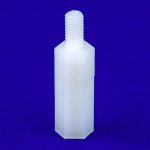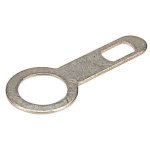OR
Going with a copper top, but not sure about alignment of OPTs (Hashimoto H-20-3.5U) as I don't know how the cores are built/aligned.
Top is 11x17 now, considering 12x18 for airflow/cooling/access.
Thanks in advance.
Norm
Or, up the middle go with PT then choke the Rec tube from back to front. Then out section on either side with the OPT in back the output tube, then input tube.
I laid mine out like this.

I laid mine out like this.
If you have a 6.3VAC voltage source, and a DMM, then . . .
Connect 6.3VAC across the choke wires (Do not worry, that will only pass 1.7mA through the choke).
Connect the DMM, set to ACV, across the output transformer's primary
Bring the choke near to the output transformer, and rotate both the choke and the output transformer until you find the highest voltage across the output transformer primary.
Rotate one of them by 90 degrees, and that should be the lowest magnetic coupling.
If you do not get enough magnetic field from the choke with 6.3VAC, then connect 120VAC across the choke wires. That will be 32mA through the choke. Careful! do not touch. 120VAC can kill.
That should be OK for the Hammond 10H 200mA choke (I use a Hammond 5H 200mA choke for input B+ filtering. It has lots more than 120VAC across it in my power supplies.
A 5H choke at 120Hz full wave rectification frequency, and the 10H choke at 60Hz AC: Both have 3770 Ohms of inductive reactance.
Have fun discovering the magnetic field orientations.
Connect 6.3VAC across the choke wires (Do not worry, that will only pass 1.7mA through the choke).
Connect the DMM, set to ACV, across the output transformer's primary
Bring the choke near to the output transformer, and rotate both the choke and the output transformer until you find the highest voltage across the output transformer primary.
Rotate one of them by 90 degrees, and that should be the lowest magnetic coupling.
If you do not get enough magnetic field from the choke with 6.3VAC, then connect 120VAC across the choke wires. That will be 32mA through the choke. Careful! do not touch. 120VAC can kill.
That should be OK for the Hammond 10H 200mA choke (I use a Hammond 5H 200mA choke for input B+ filtering. It has lots more than 120VAC across it in my power supplies.
A 5H choke at 120Hz full wave rectification frequency, and the 10H choke at 60Hz AC: Both have 3770 Ohms of inductive reactance.
Have fun discovering the magnetic field orientations.
@6A3sUMMER - Thanks. I'll play with that. Gonna be a while until I can really get into this project.
Curious about the OPT orientation though
Curious about the OPT orientation though
The axis that goes through the output transformer's coils might be vertical instead of horizontal.
Yeah, that’s what I’m afraid of. I don’t know what these look like inside. I bought them through a seller in Japan, language was a little dicey, I’ll write the company.
I thought about that… going to add 1” to the top (make it 12x18”), then something like this?

This will give me a little more room for mounting the PT chokes and the front end filament transformer inside too. Just a bit less crowded. The EML tubes (that’s a 5Z4 rectifier) need a little space, I think.
Going to use steel, not copper. I just thought it looked really cool on the Tektron amp I bought, but a suitably large and THICK piece is prohibitively expensive and is likely to warp over time under all that weight - or so my roofer friend tells me.
This will give me a little more room for mounting the PT chokes and the front end filament transformer inside too. Just a bit less crowded. The EML tubes (that’s a 5Z4 rectifier) need a little space, I think.
Going to use steel, not copper. I just thought it looked really cool on the Tektron amp I bought, but a suitably large and THICK piece is prohibitively expensive and is likely to warp over time under all that weight - or so my roofer friend tells me.
I'd keep the small filament transformer farther away from the audio circuitry.
Maybe mounted on the right inner side of the chassis.
Maybe mounted on the right inner side of the chassis.
Ah, right. Thanks. There should be plenty of room inside with 4” maple sides to even screw those down into the wood.
Yes, or mount on a metal plate, and attach the plate to the side.
You may need some tie points on the plate for longer wires.
Where are the filter capacitors?
The two smaller ones are PS chokes for filtering?
You may need some tie points on the plate for longer wires.
Where are the filter capacitors?
The two smaller ones are PS chokes for filtering?
Last edited:
Never adhesive, it won't last long, especially in a hot chassis.
Use only terminals rated at enough DC voltage.
For reliability, only do soldered connections.
Use only terminals rated at enough DC voltage.
For reliability, only do soldered connections.
So far this is the only information I can come up with on my own and it’s still not clear about the OPT core orientation wrt PT core plates: http://www.tube-amps.net/Technical_Aspects.htm
Looks like the UX-4 tube sockets there for 300B are gold plated. This is good if the tube pins are also gold plated (EML and some other higher-cost 300Bs), but gold plating should not be mixed with tin plated pins (Western Electric and many others).
From a connector mfr:
https://www.molex.com/en-us/blog/gold-or-tin-vs-gold-and-tin
From a connector mfr:
https://www.molex.com/en-us/blog/gold-or-tin-vs-gold-and-tin
Well, this might answer my qustion about orientation of PT vs. OPT.
Also:
1 - I’ve got plenty of connector/terminal strips, tags, etc., for the project (not my first rodeo).
2- I own a pair of EML 300b tubes, gold-plated pins. The UX-4 socket for the rectifier is AA, silver-plated, as are the octal sockets. @Rod Coleman - thanks, I’ll re-read that article; after nearly 50 years of tinkering with audio and ham radio gear (SS and tube), there are still areas where “engineers” (and there’s a special place in hell for “engineers” IMHO), metallurgists, “specialists” (you know, a specialist being someone who knows more and more about less and less until he knows absolutely everything there is to know about nothing) and other former perts (EX-perts) argue, maintain, opine, remonstrate, stamp they widdle feets…
3- TEKTRON amp I also own has sticky-backed pads on a copper top holding capacitors and other components/wiring in place. Amp is about 20 years old, so I don’t think heat is a problem.
4- @rayma - yes, the two smaller ones are filters for independent PS tracks for B+ to tubes, capacitors all go inside. Probably the power resistors as well, just put all those larger components on top to get an idea of utilization of available space inside



Also:
1 - I’ve got plenty of connector/terminal strips, tags, etc., for the project (not my first rodeo).
2- I own a pair of EML 300b tubes, gold-plated pins. The UX-4 socket for the rectifier is AA, silver-plated, as are the octal sockets. @Rod Coleman - thanks, I’ll re-read that article; after nearly 50 years of tinkering with audio and ham radio gear (SS and tube), there are still areas where “engineers” (and there’s a special place in hell for “engineers” IMHO), metallurgists, “specialists” (you know, a specialist being someone who knows more and more about less and less until he knows absolutely everything there is to know about nothing) and other former perts (EX-perts) argue, maintain, opine, remonstrate, stamp they widdle feets…
3- TEKTRON amp I also own has sticky-backed pads on a copper top holding capacitors and other components/wiring in place. Amp is about 20 years old, so I don’t think heat is a problem.
4- @rayma - yes, the two smaller ones are filters for independent PS tracks for B+ to tubes, capacitors all go inside. Probably the power resistors as well, just put all those larger components on top to get an idea of utilization of available space inside
NormB,
From the pictures of the Hashimoto output transformers,
The magnetic field Axis appears to be Vertical.
Wth a vertical axis, you still have two other 90 degree orientations of the power transformer and choke that are not the same as the output transformer.
Test for this, activate the choke as I said earlier, and lay the output transformer on its side.
Then you should see the signal more strongly, versus when the output transformer is mounted right side up.
From the pictures of the Hashimoto output transformers,
The magnetic field Axis appears to be Vertical.
Wth a vertical axis, you still have two other 90 degree orientations of the power transformer and choke that are not the same as the output transformer.
Test for this, activate the choke as I said earlier, and lay the output transformer on its side.
Then you should see the signal more strongly, versus when the output transformer is mounted right side up.
- Home
- Amplifiers
- Tubes / Valves
- 300B Board Layout question

